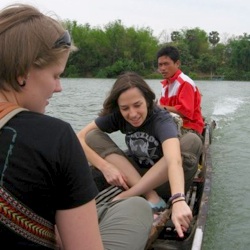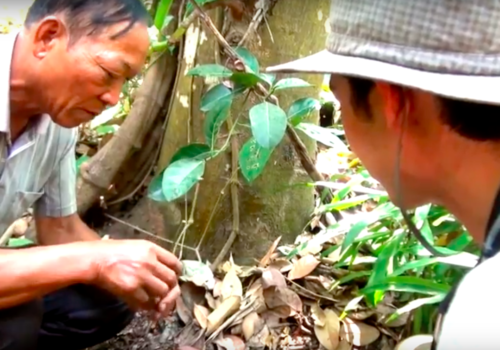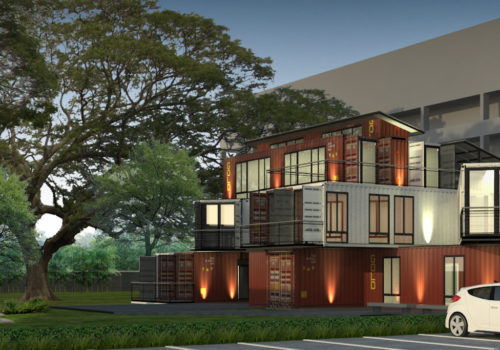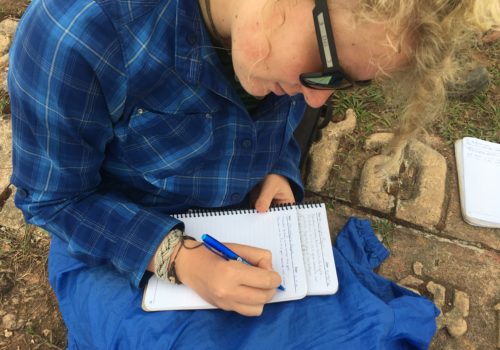
Annie, Rebecca and a friend on the Mun River
The Rivers Course ended just before break, and I wanted to spend a bit of time following up on my earlier post about prepping for the course, and give folks an insight into some of the students’ take on the course.
The course starts in Nong Po village in Ubon Ratchathani province, along the Mun River. This is the site of the Pak Mun Dam, which has wreaked destruction on the local ecologies and communities. The families we stayed with were no exception. Couragous, hard working, and up against the collapse of their traditional source of income, livelyhood and meaning. They opened their homes and hearts and welcomed us in, teaching about the rivers, fish and fishing, and their struggle against the dam and the hope that it will someday be decomissioned. Everyone has children who have left to work in Bangkok and send money home, as fishing no longer provides the income or protein that it used to.
Throughout the stay many community members remarked on how glad they were that the students were there to learn. There is a lot of empowerment that happens when you get to tell your story, and while we as instructors and students don’t have the power to open the gates of the dam, we can listen. It is a challenge–especially for American’s–to just listen and be with people, and not “do” something. However, that listening to stories, standing with people is, as local activist Khun Suwit said, the most important thing students can do, as it builds community globally, person by person, connection by connection.
After the time in the village, we travelled up the Mekong river for a few days, and then to the village of Don Chai in Phrea. Here the local activists have (so far) blocked the construction of the dam on the Yom river, saving both their homes and the last stand of golden teak in Thailand from being innundated by the dam. Meeting with village elders as well as the young activists was inspiring–old and young joined in keeping their river alive, and their homes safe. It isn’t a stuggle that is easy or over, as they pointed out that they need to keep vigilant and be aware of the many ways the government is working to push through the dam (and get the chance to log the millions of dollars worth of teak), building a road to the proposed dam site, etc.

Paw Sang'uan talking about fish catches on the Yom river.
We then spent the next week paddling down the river with the community, fishing, camping, and learning about ecology and the rich and healthy ecosystem that the Yom river supports. Yet even the Yom, as healthy as it is, has a dam downstream of the area we were, and the large fish that used to migrate up river are gone. The local communities have a fish conservation area that serves to keep the surviving native fish populations healthy, but that too would be wiped out if the dam is ever built. It was fun, challenging, and a striking reminder of what was lost on the Mun.
During Expedition Field Courses at ISDSI students keep a journal and write essays about what they are learning. A number used them as inspiration for their blogs. Here are a few short excerpts from the some of the students. I’d encourage you to jump to the blogs and read about the course, its impact and their reflections on what they learned.
Acadia wrote about the blessing from the villagers of Nong Po:
I can count my blessings on one hand. To be exact, there are 26 of them currently encircling my wrist. Twenty-six thin white strings, a knot tied at the center of each. As these blessings were bestowed more than three weeks ago, they are frayed and rather brown, a situation that prompted my host mom to hint it might be time to cut them off. I can’t bring myself to do this just yet…
[In the village] The oldest of my host sisters hurried over with a huge, heartbreaking smile and deftly blessed me with her slender little brown fingers. Before she left, she turned over my hand to the roll the ends of the thread softly along the tender skin of my inner wrist until they curled and twisted with the ends of other strings. Something about that simple touch, the whispered prayers, the sincere smile made me never want to forget the moment. I tried to look at each person who came to me and burn their face into my memory forever. The experience was so human. To feel that the entire village was behind my well-being made me feel more whole.
Jonathan, commenting on a village meeting:
We then asked them questions.
Q: Are there fewer fish now than before the dam was built?
A: Yes. There used to be more fish. And bigger fish. There used to be over 200 species of fish. Now there are 50 species. In one rainy season, they used to catch over 1000 kg of fish. Now they only catch 40 kg.Q: How can you survive with so few fish?
A: We can’t.Q: Since many of your livelihoods centered around the fish in the river, what do you do for food or money now?
A: We send our children to work in factories in Bangkok. They send money home.Q: How many of you have children in Bangkok?
A: All the hands go up.Q: How many of you have several children in Bangkok?
A: All the hands stay up.
The meeting progressed like this. We kept getting deeper and deeper into the impacts this dam has had on the community. One fisherman said he used to have a good life before the dam was built. He was a wealthy man with fish to feed his family and even more fish to sell. But now he is poor. He has been made poor. He has no rice fields or gardens to grow vegetables- he relied on the longevity of that river… There is no more money left to spent on protest- the next generation of young people is all working in other cities, and the youngest know nothing of their parents’ struggles.
It was at this point in the meeting that one of the villagers stood up and asked us a question.
What are we going to do about it?
Did we just come to study them and leave? They shared their struggle with us. What are we going to do with that?We were stunned silent, at a loss for an answer, and that was basically how the meeting ended. We had come to love these villagers and they were gracious to us. They shared what they had with us and we listened to them tell their story. Even though they aren’t sure if we can help them (i’m sure all of us will try), by us being there and sitting at their feet, we validated them. They were thankful and so were we. It was an intense and touching experience to become apart of the community of Nong Po.
Rebecca, on the village and the river:
I’m trying to be quiet more often. To listen more fully. To pay attention to silent spaces.
This time studying river ecosystems and issues having to do with human rights has set before me an incredible narrative, of the relationship between humans and their environment, a connection that holds both sorrow and joy. I’m not quite sure how to share this through a blog post, but I’ll try.
In Thai, the word for river is “Meh Nam,” which literally translates as “Mother Water.” This reality, one of life bound up in the river, was humbly evident in the two communities that we stayed over the past two weeks….
Nawg Poh today is a place lacking a generation, where young adults have been forced to leave and search for work elsewhere. Most move to Bangkok or other larger cities, as wage laborers and migrant construction workers. The people of Nawg Poh (mostly grandparents and grandchildren) expressed their mourning not only for the river, but also for their culture and way of life.
Ally:
Why am I here? That is a question I have been thinking about constantly the past few weeks. These thoughts started after the community meeting and was heightened at the mid-block seminar. I definitely did not know what I was getting into when I applied fro this semester. I didn’t know that I would be in a village that has been directly affected by the building of the dams, or even see and experience human rights/earth rights abused first hand. I didn’t know that each community that I will be staying with will take a piece of my heart. I didn’t think that I would be struggling over issues that villagers have been experiencing for many years. I didn’t know it would be this difficult!
I definitely felt a huge sense of guilt. I felt like I needed to do something, but didn’t quite know just what it was. The seminar definitely helped channel my thoughts and understand that I have already done a lot. Just by sitting there and listening to the stories of the villagers and participating in their culture was a way to empower the community. Hopefully, I have showed them that someone cares about their village and what has happened to them. Maybe I even gave them a sense of hope and dignity. I struggle with this. Is it just a cop out to say that I did all I could by listening to their stories? They even said themselves that they are tired and can’t think of anything else to do. I think the only way that I can truly grasp this idea is by figuring it out myself with the right of participation…
This course was not extremely difficult in material content, but the emotional impact of this course was and still is difficult to fully comprehend. Each place I went I feel like I left with a new connection. The family in Nong Bo said that I am always welcome, and the Paws and other activists on the Yom River were amazing to get to know and have actually become our friends. My life has been affected by these people, and I don’t think they will ever know to what degree. Pi Kan (Don Chai activist) said at the end of our trip that we have experienced a learning experience that goes both ways. I just hope that the people we were with got as umch out of spending time with us as we got out of spending a month with them. My hope is that we were able to empower them, give them hope, and support for their struggle.
For some great photos of the course, check out Jeremy’s blog (that is his photo of Pa Sanguan above, and the photo of Annie and Reb is from Reb’s blog).



